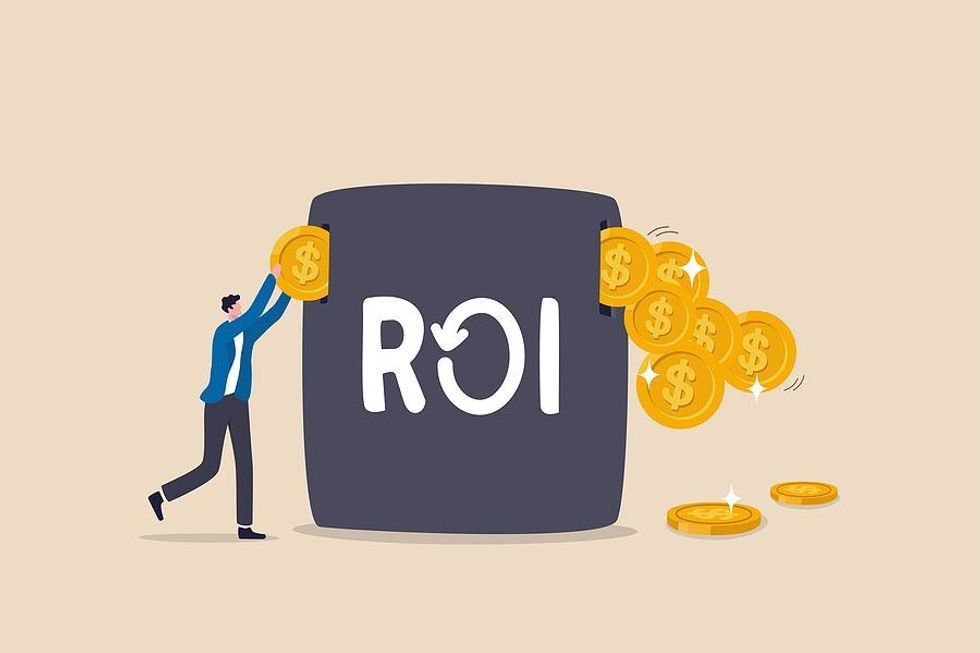
A very experienced technical sales professional told me something very interesting. Nearly all business-to-business sales attempt to replace an existing solution. He said: “Companies buy solutions that produce the same outputs for a lower price or produce more outputs for the same price."
What Is A Return On Investment (ROI) Calculation?

Bigstock
ROI calculations are thought experiments to show your audience what will happen if they switch from their existing solution to the proposed new solution. It’s used in the sales process to stimulate discussion.
As a conversation starter, the calculation doesn’t have to be totally accurate. Where you don’t have the full figures, you can make assumptions. They must be based on some sort of reality such as industry benchmarks, for example.
Be conservative in your estimates. If a customer says you have underestimated the savings they will make, then they are selling themselves the product.
Here is a step-by-step guide to how to prepare an ROI calculation, using savings made with a voice biometric authentication system as an example.
Step 1: Define The Experiment
 Bigstock
BigstockDecide what effect switching to the new solution will have. Consider the financial value of the cost reduction or increase in productivity. The voice biometric system won’t make any money itself. It will eliminate the need for agents to ask the customer security questions, so reducing call lengths by approximately 1 minute.
Step 2: Define The Current (Control) State

Bigstock
Scientific experiments often have a control. In drug trials, two rats are injected with the target pathogen. One is injected with the drug, while the other isn’t. This second rat is the “control.” It demonstrates what happens if the drug isn’t used.
The basic scenario of the ROI calculation does the same thing.
Assume our contact center has 100 agents on the phones. Each agent handles 100 calls a day and each call is approximately 3 minutes long. Agents are paid USD 10.00 per hour. The agents work 7 hours a day (Breaks are unpaid), 47 weeks per year not including holidays and sickness. Cost per call = USD 70.00 / 100 calls = USD 0.70 per call.
Step 3: Define The Effect Of The Experiment
 Bigstock
BigstockNow we define what happens, from the financial perspective, when we use the new solution. In our example, removing the security questions will reduce the call length by 1 minute. Calls are now 2 minutes long instead of 3, so agents can make 150 calls in the time they handled 100 calls. The new cost per call will be USD 70.00 / 150 calls = USD 0.46 per call.
Step 4: Define The Savings

Bigstock
We have defined the financial situation before adopting the product and after adopting the product. Now we calculate the savings by deducting one from the other. Before product adoption, the cost per call is USD 0.70 per call. After product adoption, the cost per call is USD 0.46 per call. The savings will therefore be USD 0.24 per call.
Step 5: Introduce The Solution Cost To Calculate The True Savings
 Bigstock
BigstockThe solution itself has a cost. We must factor this into the savings calculation to see if it’s worth buying.
Traditionally, on-premises software was sold with a single license fee and a small annual maintenance fee as a follow-up. Nowadays, software is more likely to be sold under a monthly or quarterly subscription fee or, if it is cloud-based, as a consumption charge. It’s important to express savings in the same time frame as the solution costs.
To keep things simple, let’s assume that our product is priced as a monthly subscription based on the number of named users. The subscription fee is USD 150.00 per agent per month.
An agent handles 150 calls per day for 21 days per month (assuming we lose 2 working days per month to holidays and sickness) which comes to 3, 150 calls per month. Monthly savings will therefore be USD 0.24 per call x 3,150 calls = USD 756.00 per agent per month.
Net savings is the monthly savings minus the subscription fee. USD 756.00 – USD 150 = USD 606 per month. Multiply that by the 100 agents working in the contact center, and you have a total monthly saving of USD 60,600 per month. Multiply that by 12, and you have a savings of USD 727,000 per year.
Skull Busters

Bigstock
Sometimes customers will tell you they want to do something like “improve CSAT.” The financial benefits are not always obvious. In my experience, the best way to address this is to ask the customers themselves what such improvements will mean financially.
If they can’t tell you this, then they may not really know why they are buying the product.
If they tell you every 1% improvement in NPS scores will lead to a USD half million increase in revenues, build that into your numbers.
If you think the savings look too optimistic, present your more “realistic” figure. Explain that you want to err on the side of caution. Your customer will be reassured by your transparency and prudence.
Presentation

Bigstock
Your “ally” in the customer’s company may ask you for the ROI calculation to help her persuade the board that buying your solution is a good idea. Provide her with an easy-to-understand presentation with explanatory notes explaining what the facts are and where they come from, what the assumptions are and what they are based on, and what the calculations are and how they were calculated.
She may need to present the calculation without your help.
Wrap-Up
Are you trying to prepare an ROI calculation? Let me know if you need any help!
Further reading...
Try reading this article about building your business case. It might help you flesh out your calculations with some narrative.
- “What's In It For Me?” The 3-Stage Guide To Answering This Question ›
- 3 Ways To Emphasize Your ROI On Your Resume - Work It Daily ›
- How To Quantify Work Experience On Your Resume - Work It Daily ›
- How A Software Company Can Compete With Spreadsheets - Work It Daily ›
- Maximizing IT Investment For Long-Term Success - Work It Daily ›

 Bigstock
Bigstock Bigstock
Bigstock Bigstock
Bigstock


